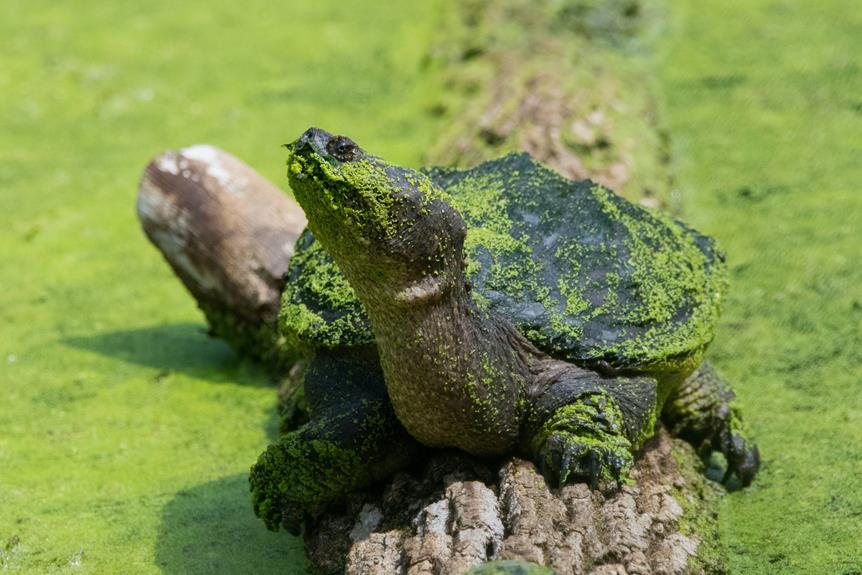Exploring the realm of home aquariums, Java Moss emerges as a pivotal element, particularly when considering its temperature preferences and the array of benefits it brings to aquatic environments.
As aquarists aim to cultivate thriving underwater ecosystems, understanding the nuances of Java Moss's temperature requirements becomes paramount. Beyond its warmth-loving nature, this plant's role in enhancing water quality, promoting oxygenation, and serving as a breeding ground for aquatic life sparks curiosity and underscores its significance in tank maintenance.
Dive into the world of Java Moss to uncover how its temperature needs intertwine with its multifaceted contributions to home tank setups.
Key Takeaways
- Optimal temperature range: 80-85°F crucial for Java Moss growth
- Stable environment promotes new branch development
- Acts as natural filter, improving tank cleanliness
- Enhances oxygen levels, controls algae growth
Importance of Java Moss Temperature
Understanding the optimal temperature requirements for Java moss is paramount for ensuring its thriving growth and overall health in aquarium settings. Temperature regulation plays a crucial role in the growth stimulation of Java moss.
Java moss thrives in slightly warm water, typically around 80 to 85 degrees Fahrenheit, mirroring its native tropical climate. Even a slight temperature change can stimulate new branch growth in Java moss, making it essential to maintain a stable and suitable environment for this aquatic plant.
Optimal Tank Temperature for Java Moss
Maintaining the appropriate temperature range is paramount for the optimal growth and health of Java moss in aquarium settings. Java moss thrives best in slightly warm water, with the ideal tank temperature ranging around 80 to 85 degrees Fahrenheit. Proper temperature regulation plays a crucial role in stimulating growth and ensuring the vitality of Java moss.
Some key points to consider for maintaining the optimal tank temperature for Java moss include:
- Consistent temperature monitoring is essential for Java moss health.
- Slight temperature fluctuations can impact the growth rate of Java moss.
- Avoid drastic temperature changes to prevent stress on the moss.
- Provide a stable and warm environment to promote healthy Java moss growth.
Stimulating Growth With Temperature Changes
Stimulating growth in Java moss can be achieved by carefully adjusting the temperature within the optimal range of 80 to 85 degrees Fahrenheit in the aquarium environment. Temperature manipulation plays a crucial role in promoting the growth of Java moss. Slight changes in temperature can trigger new branch development, leading to a denser and healthier moss bed.
Tank Cleaning Benefits of Java Moss
One notable advantage of Java Moss in home tanks is its ability to purify the aquatic environment through efficient debris absorption and filtration mechanisms. Java Moss contributes to tank cleaning and maintenance in several ways:
- Debris Absorption: Java Moss absorbs and traps debris, helping to keep the tank clean.
- Filtration: It acts as a natural filter by trapping particles and waste, improving water quality.
- Algae Control: Java Moss limits algae growth by competing for nutrients and reducing light exposure.
- Aquascape Enhancement: Its lush greenery adds a natural aesthetic to aquascape designs, enhancing the overall visual appeal of the tank.
These tank cleaning benefits make Java Moss a valuable addition to home aquariums, aiding in maintaining a healthy aquatic environment.
Oxygen Production by Java Moss
Java Moss contributes significantly to the oxygen levels in a home tank through its photosynthesis process, enhancing the overall aquatic environment's health and vitality. By absorbing carbon dioxide and releasing oxygen during photosynthesis, Java Moss plays a crucial role in improving aeration within the tank. This process is essential for maintaining optimal oxygen levels that are vital for the well-being of aquatic organisms.
Adequate oxygen levels provided by Java Moss support aquatic health by ensuring that fish and other tank inhabitants can respire efficiently. Therefore, incorporating Java Moss in your aquarium not only adds to its aesthetic appeal but also promotes a balanced ecosystem by contributing to oxygen production and enhancing overall aquatic health.
Algae Control With Java Moss
Utilizing Java Moss in your home tank can effectively aid in controlling algae growth through its natural inhibitory mechanisms. Java Moss plays a crucial role in maintaining tank aesthetics and water quality by preventing algae overgrowth.
Here are four key ways Java Moss helps in algae control:
- Algae prevention: Java Moss competes with algae for nutrients, limiting their growth.
- Nutrient absorption: The moss absorbs excess nutrients like nitrates and phosphates, reducing algae-friendly conditions.
- Water quality: By absorbing ammonia and nitrites, Java Moss helps maintain a healthy aquatic environment.
- Aesthetic enhancement: Its dense growth pattern provides shade, reducing light availability for algae and enhancing the tank's visual appeal.
Java Moss as Breeding Grounds
When considering the role of Java Moss in aquarium settings, its function as a natural breeding ground for aquatic organisms emerges as a key aspect of its biological significance.
Java Moss provides a conducive environment for breeding due to its dense and intricate structure, offering shelter and protection for newly hatched fry and eggs. The fine leaves and branching patterns create a safe haven for various fish species to spawn and forage, enhancing their breeding habits and success rates.
In this aquatic environment, Java Moss serves as a vital component in supporting the reproductive cycles of aquatic organisms, contributing to the overall biodiversity and sustainability of the tank ecosystem. Its ability to mimic natural habitats makes it an ideal substrate for fostering breeding activities in aquariums.
Utilizing Java Moss as Aquatic Food
In the context of aquarium ecology, the nutritional value of Java Moss as a viable source of sustenance for aquatic organisms garners attention for its potential impact on the overall ecosystem balance. Java Moss can serve as a valuable food source in aquatic environments, providing essential nutrients for various species.
When utilized as aquatic food, Java Moss offers benefits such as:
- Rich in aquatic nutrition, supporting the health and vitality of fish and invertebrates.
- Enhances the natural environment of the tank, contributing to a more balanced ecosystem.
- Can be used as a supplement to commercial fish food, diversifying the diet of aquatic inhabitants.
- Adds a decorative element to the tank while serving a functional purpose in promoting aquatic health and well-being.
Frequently Asked Questions
Can Java Moss Survive in Colder Water Temperatures if Necessary?
Java moss, native to tropical climates, may struggle in colder waters impacting growth rate. Its temperature tolerance is limited, with maintenance requirements crucial for survival. Coldwater suitability for java moss may be challenging due to these factors.
How Often Should Java Moss Be Trimmed to Promote Healthy Growth?
Regularly trimming java moss is key to fostering vigorous growth. To promote healthy development, consider trimming every 2-3 weeks, focusing on dense areas for optimal light exposure. Utilize trimmed portions for propagation, enhancing your tank's lush appearance.
Are There Any Potential Negative Effects of Java Moss Overgrowth in a Tank?
Overgrowth of Java Moss in a tank can lead to reduced water flow, hindering filtration efficiency. Excessive moss can overcrowd other plants, impacting biodiversity. Careful trimming, regular maintenance, and monitoring are essential for tank balance, aesthetics, and algae control.
Can Java Moss Be Used in Brackish Water Aquariums, or Is It Strictly for Freshwater Tanks?
Java moss, a versatile plant known for its adaptability, thrives in freshwater environments. While it may struggle in brackish water due to salt content, its coldwater adaptation remains a limitation for compatibility in such settings.
Are There Any Specific Types of Fish or Invertebrates That Particularly Benefit From Having Java Moss in Their Tank?
Fish compatibility and invertebrate benefits of Java Moss include providing shelter and spawning sites for species like bettas, shrimp, and fry. Its lush greenery enhances tank aesthetics, promoting natural aquascape design while fostering a healthy aquatic environment.
Conclusion
In conclusion, maintaining the optimal temperature for Java Moss in home aquariums is crucial for its growth and benefits. By understanding and controlling the temperature, aquarists can enhance water quality, promote oxygen production, control algae growth, and create ideal breeding grounds for aquatic organisms.
For example, a study conducted by aquatic biologists demonstrated a significant increase in fish breeding success rates when Java Moss was introduced into the tank at the recommended temperature range.





